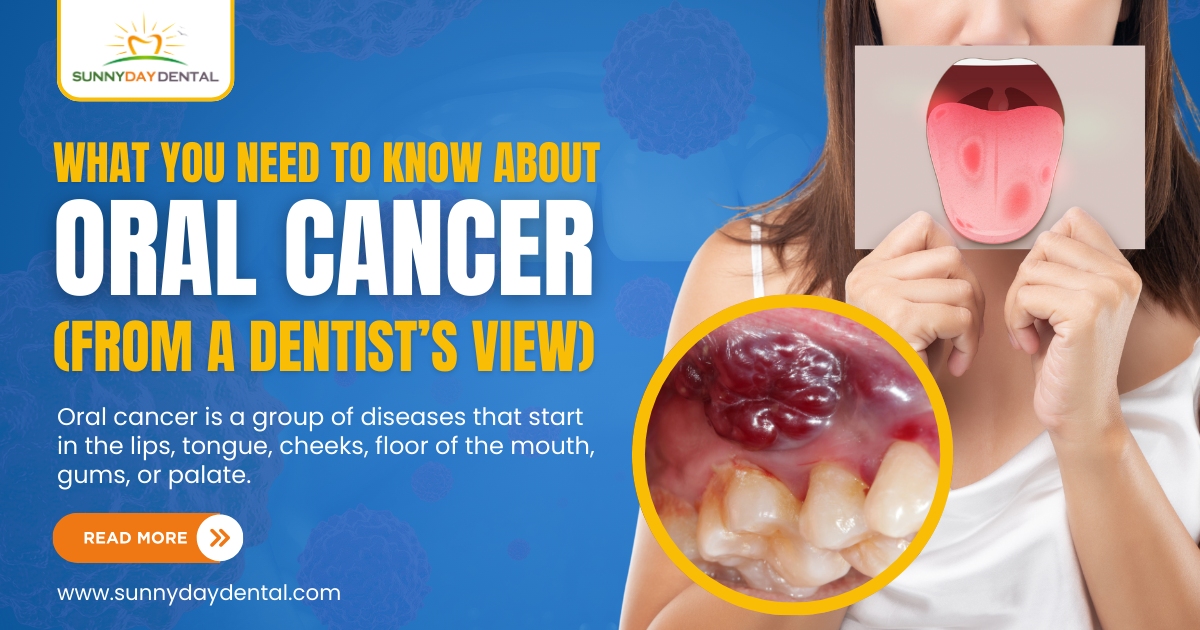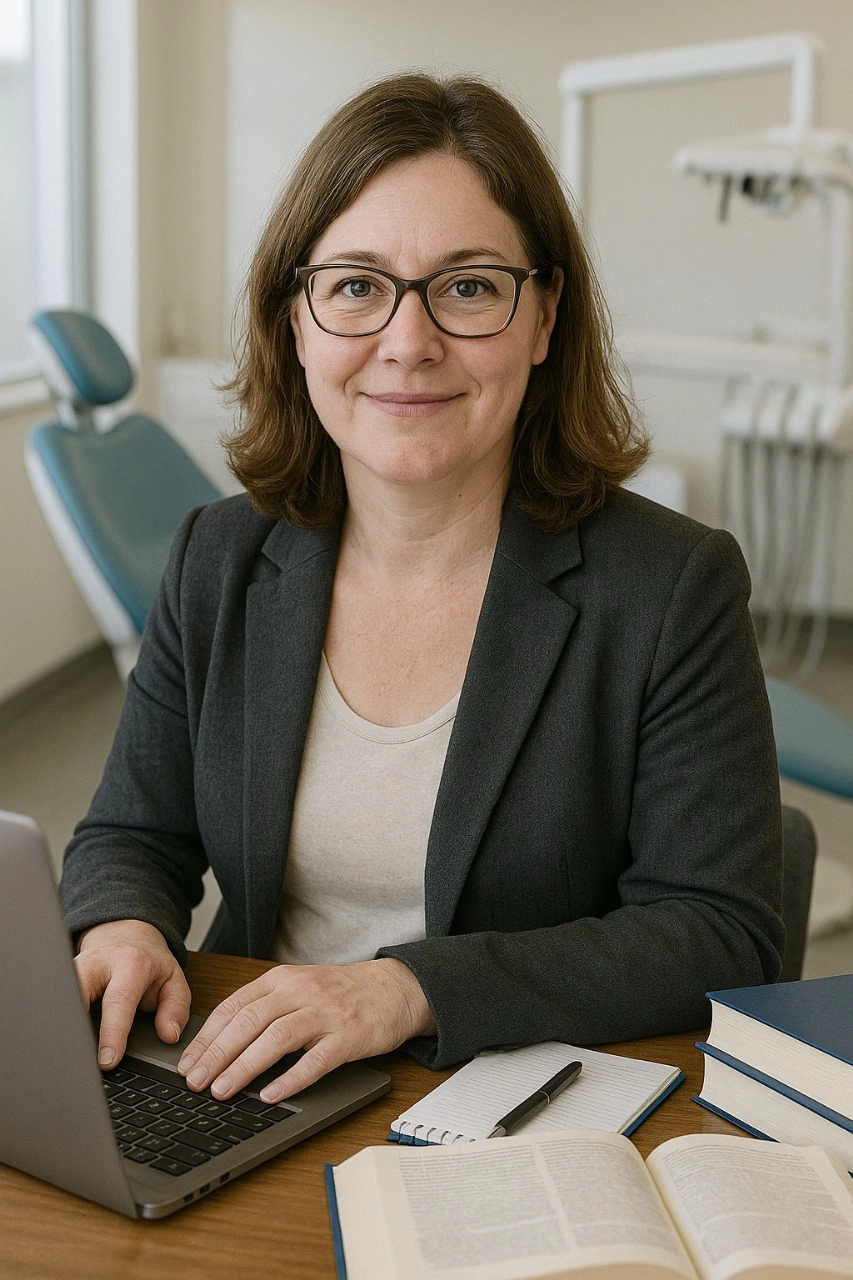Oral cancer is a group of diseases that start in the lips, tongue, cheeks, floor of the mouth, gums, or palate. Early changes can be subtle, so a fast, visual and tactile exam by a dentist during routine visits is the easiest way to catch problems early. If you notice a sore that does not heal in two weeks, a lump, or color changes, book a visit with a dentist in Woodbridge for a same-week screening.
Table of Contents
ToggleEarly detection saves time, money, and stress. As your dental team, our job is to make screening simple, explain what changes to watch for, and guide you step by step. This page walks you through how common the disease is, how it is found, what warning signs matter, why screening is important, and what happens during the appointment.
What is Oral Cancer?
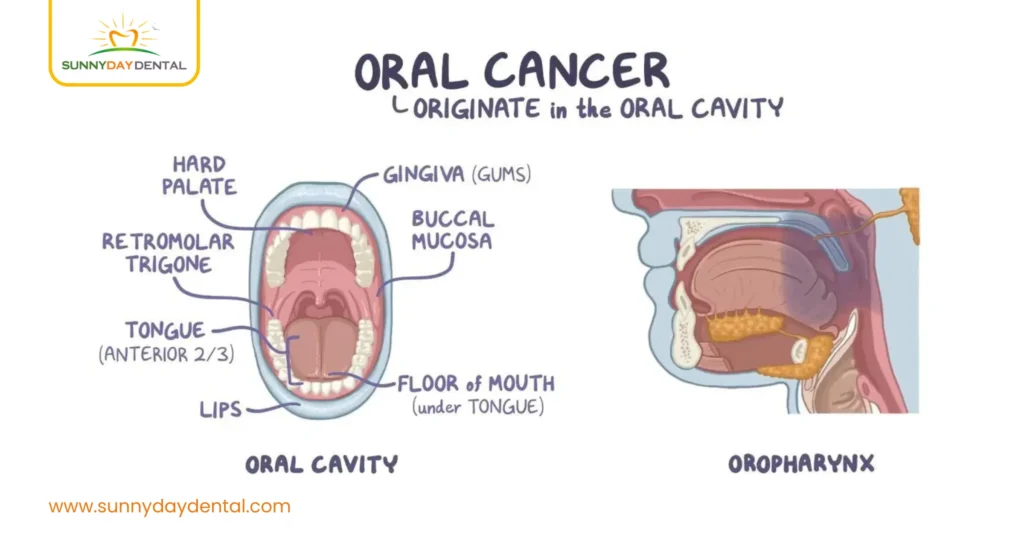
In simple terms, oral cancer refers to abnormal cells growing in areas we can see in the mouth. It can appear on the lips, tongue, inner cheeks, floor of the mouth, gums, and hard palate. Catching it early improves outcomes; that is why awareness and regular exams matter. Oral cavity cancers remain a significant global burden according to international cancer registries.
How Many People Suffer From Oral Cancer?
In Canada, oral cancer is more common than many people realize. Each year, about 5,300 new cases are diagnosed (excluding Quebec), and sadly, the disease leads to approximately 1,450 deaths. Men are affected significantly more than women, with around 3,700 men and 1,650 women receiving a diagnosis annually.
When we look at rates per population, the incidence of oral cancer is approximately 12 cases per 100,000 men and 5 cases per 100,000 women, highlighting that this disease isn’t rare anywhere in Canada.
These figures underscore the importance of awareness, early detection, and routine screenings, especially with a dental clinic in Woodbridge, where personalized care can make a real difference.
How is Oral Cancer Detected?
Dentists detect this disease through a conventional visual and tactile examination of all mouth tissues and the neck, paired with a careful review of your health history. If an area looks suspicious, your clinician will perform or refer for a biopsy, which is the only way to confirm a diagnosis.
Light-based gadgets can help examine tissues; however, they do not replace a biopsy for decision-making. Detection is most reliable when you attend routine checkups, so it is smart to pair your exam with your regular dental cleaning in Woodbridge to keep records consistent and avoid extra appointments.
If you notice a new spot or a sore that will not heal, contact a dental expert in Woodbridge and ask for an earlier visit, even if it is not yet time for your recall.
7 Symptoms of Oral Cancer
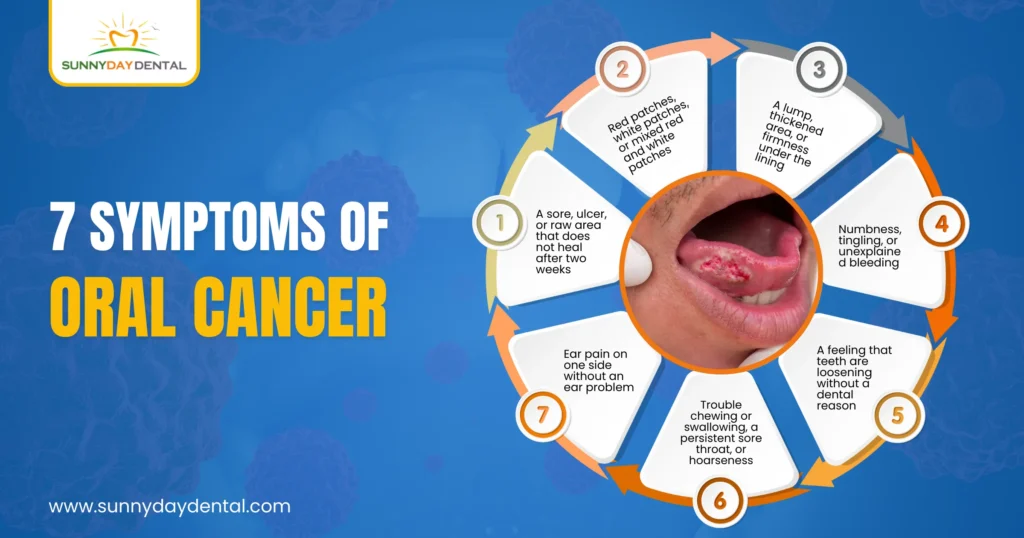
At home, learn the pattern of oral cancer symptoms so you know when to act. Many early changes are not painful, which is why people delay booking a visit.
Common warning signs you can see or feel
- A sore, ulcer, or raw area that does not heal after two weeks
- Red patches, white patches, or mixed red and white patches
- A lump, thickened area, or firmness under the lining
- Numbness, tingling, or unexplained bleeding
- A feeling that teeth are loosening without a dental reason
- Trouble chewing or swallowing, a persistent sore throat, or hoarseness
- Ear pain on one side without an ear problem
These are examples of oral cancer symptoms, not a diagnosis. Any change that lasts needs an in-person exam.
Why Early Changes are Missed
Busy schedules and mild discomfort make it easy to overlook mouth cancer early signs. Painless patches, small ulcers, or a nick that never quite heals often look minor, yet they matter. Create a quick phone photo log so your dental team can compare any area over time.
If you notice possible oral cancer symptoms, do not wait. Book a check, describe when the change started, and bring photos if you have them.
Why is Oral Cancer Screening Done?
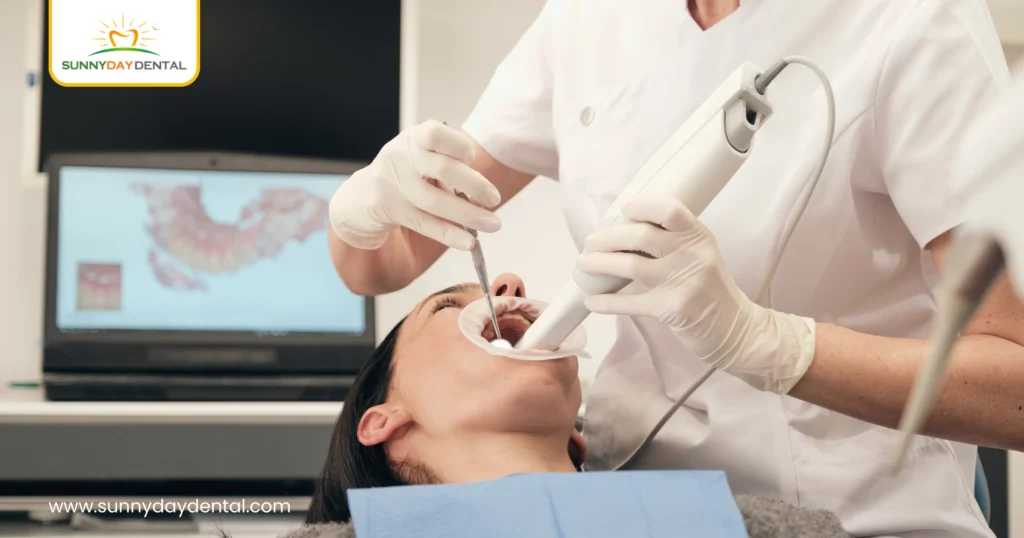
Screening finds disease before it becomes advanced, when treatment is usually simpler and outcomes are better. An exam is quick, comfortable, and can be added to your scheduled hygiene visit. It also helps catch noncancer conditions early, like fungal infections, traumatic ulcers, and precancerous patches that benefit from timely care.
Screening matters because mouth cancer early signs are often painless and may look like a bite mark or a canker sore. Regular checks reduce the chance of missing that small but important change.
Your dentist also uses the visit to lower risk with practical advice, for example, quitting tobacco, limiting alcohol, protecting lips from the sun, eating a produce-rich diet, and discussing HPV vaccination when appropriate.
The HPV vaccine is routinely recommended through age 26, and from 27 to 45, it can be considered using shared clinical decision making.
What Can You Expect During An Oral Cancer Screening?
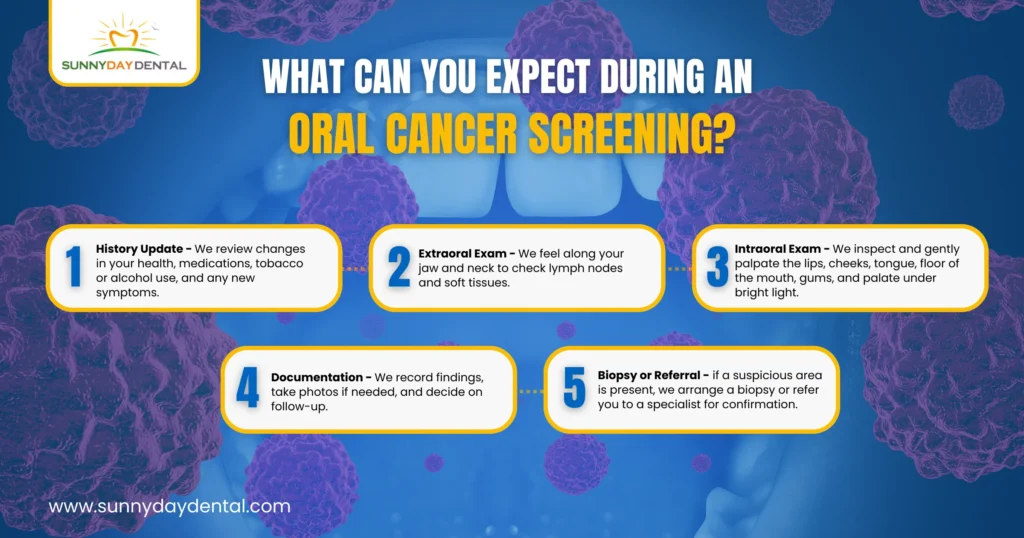
Knowing the steps reduces worry. Many patients combine screening with their dental cleaning in Woodbridge, which keeps the process efficient.
Step by step, what we do:
- History Update – We review changes in your health, medications, tobacco or alcohol use, and any new symptoms.
- Extraoral Exam – We feel along your jaw and neck to check lymph nodes and soft tissues.
- Intraoral Exam – We inspect and gently palpate the lips, cheeks, tongue, floor of the mouth, gums, and palate under bright light.
- Documentation – We record findings, take photos if needed, and decide on follow-up.
Biopsy or Referral – if a suspicious area is present, we arrange a biopsy or refer you to a specialist for confirmation.
After the Visit
You will leave with either reassurance and a reminder for your next check or a clear next step with timelines and instructions. If we are watching a minor change, we will show you how to track it at home. The process is thorough and calm, and it fits neatly into your calendar.
If you are unsure whether a spot is urgent, call a dentist in Woodbridge and ask for a same-week appointment. A short appointment now can prevent a longer treatment later.
When to See a Dentist Immediately
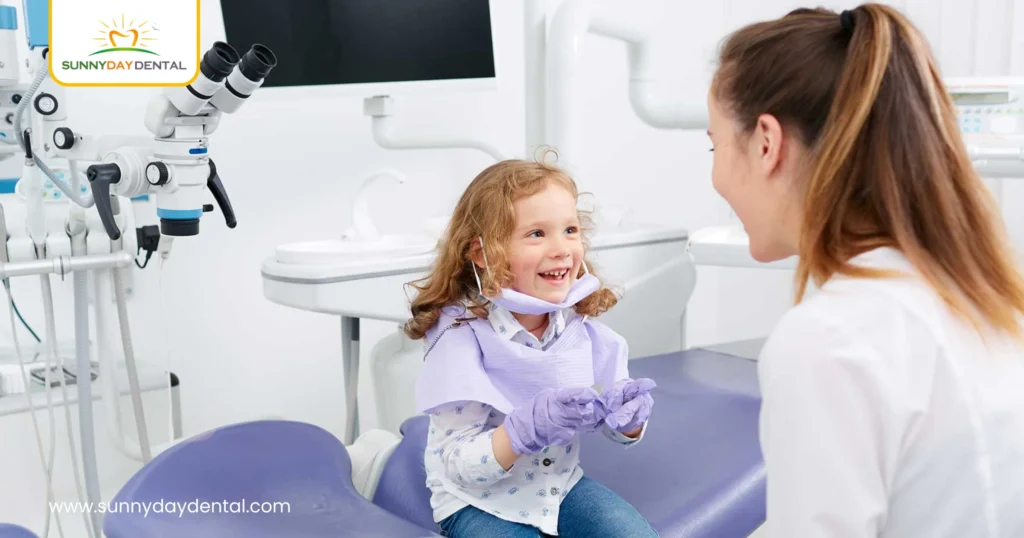
If you have a sore that does not heal after two weeks, persistent pain or numbness, a new lump, difficulty swallowing, a chronic sore throat, ear pain without an ear problem, or loose teeth without a clear cause. If a symptom worries you, do not wait; call a dentist in Woodbridge and ask for a same-week appointment.
What Happens During a Visit to Sunny Day Dental
Our team builds cancer checks into every hygiene and exam appointment, so screening never feels like an extra chore. If you prefer efficient visits, pairing your screening with dental cleaning in Woodbridge saves time and keeps records consistent. We document what we see, we photograph changes when helpful, and we help you plan the next step with clarity.
Take The First Step Toward Oral Health with Sunny Day Dental
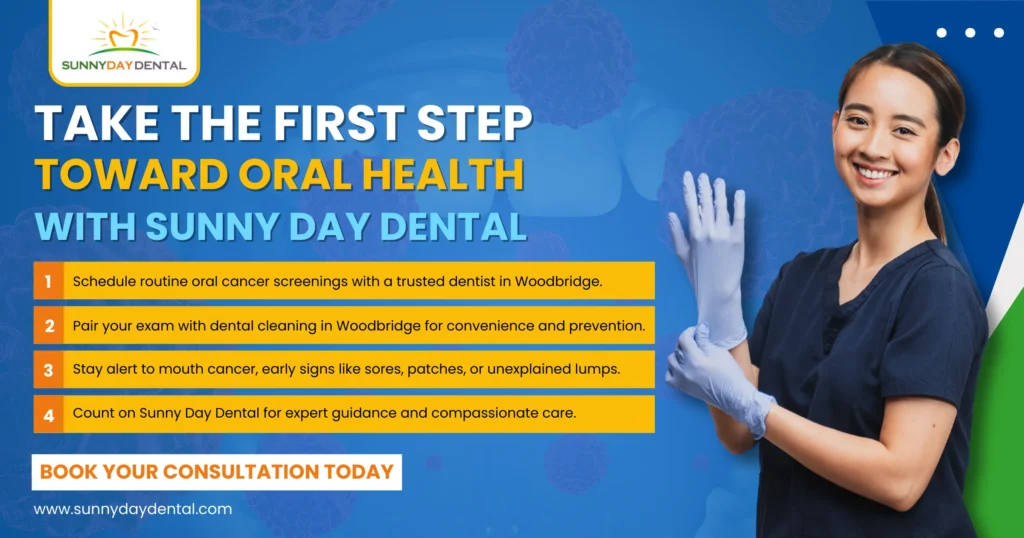
Your smile deserves proactive care. Early detection and regular screenings can protect not only your teeth but also your overall health.
- Schedule routine oral cancer screenings with a trusted dentist in Woodbridge.
- Pair your exam with dental cleaning in Woodbridge for convenience and prevention.
- Stay alert to mouth cancer, early signs like sores, patches, or unexplained lumps.
- Count on Sunny Day Dental for expert guidance and compassionate care.
FAQs About Oral Cancer
1. How often should I be screened for oral cancer?
Most adults benefit from an annual oral cancer screening during their routine dental visit. If you use tobacco, drink alcohol regularly, or have a history of oral cancer, your dentist may recommend more frequent checks.
2. Can oral cancer develop without pain?
Yes. Many mouth cancer early signs, like small patches or lumps, are painless in the beginning. That’s why regular exams are so important, because pain isn’t always an early warning sign.
3. What is the difference between a canker sore and oral cancer symptoms?
A canker sore usually heals on its own within 1–2 weeks and is often tender. Oral cancer symptoms, like a sore that does not heal or a patch that changes colour, tend to last longer and may feel firm at the base.
4. Does oral cancer only affect smokers?
No. While tobacco is a major risk factor, oral cancer can also develop in people who don’t smoke. Alcohol use, HPV infection, sun exposure on the lips, and genetics can all play a role.
5. What can I do today to lower my risk of oral cancer?
You can quit tobacco, reduce alcohol, protect your lips with SPF, maintain a produce-rich diet, and keep regular dental checkups. Pairing screenings with your teeth cleaning in Woodbridge makes prevention easier and more consistent.

